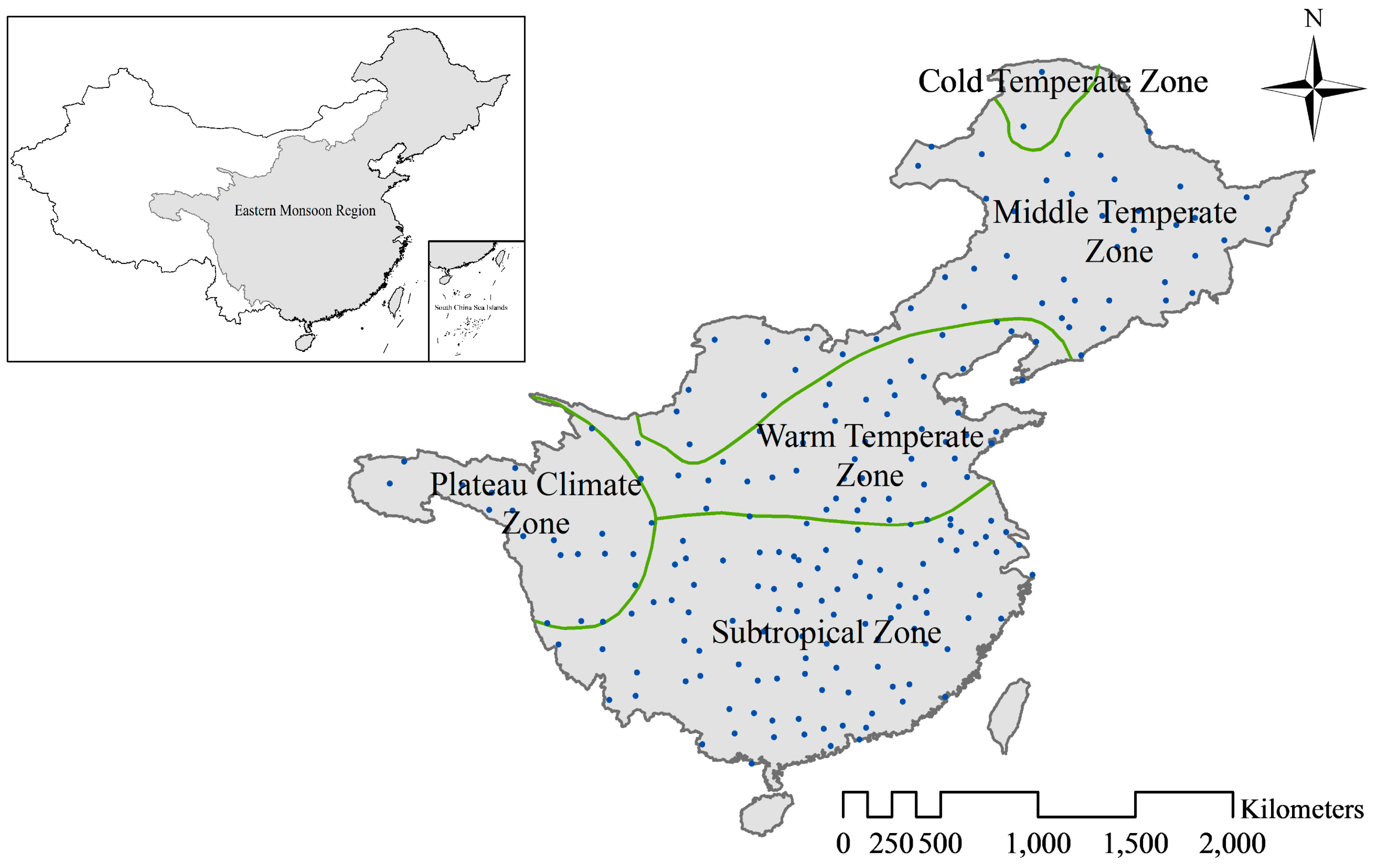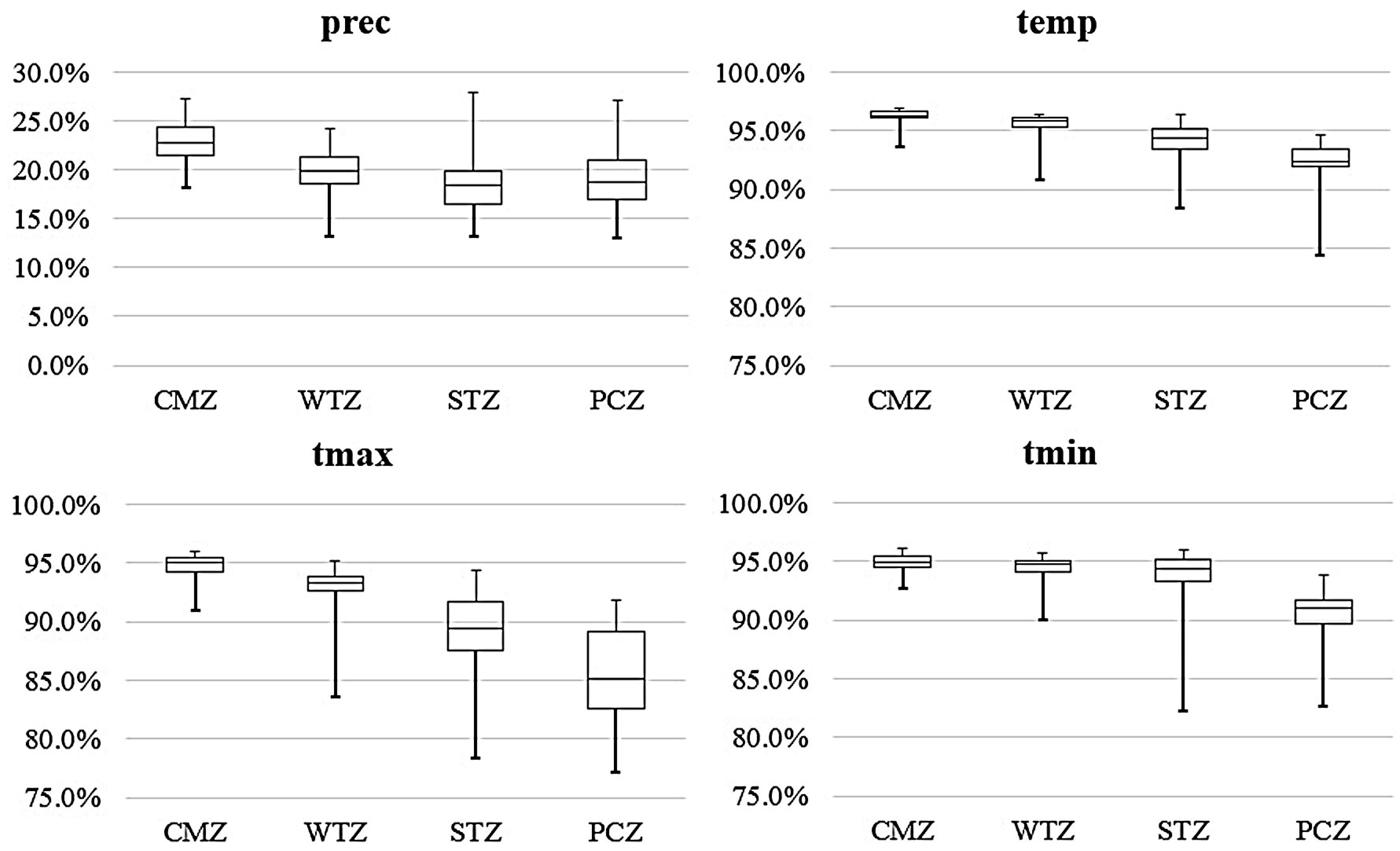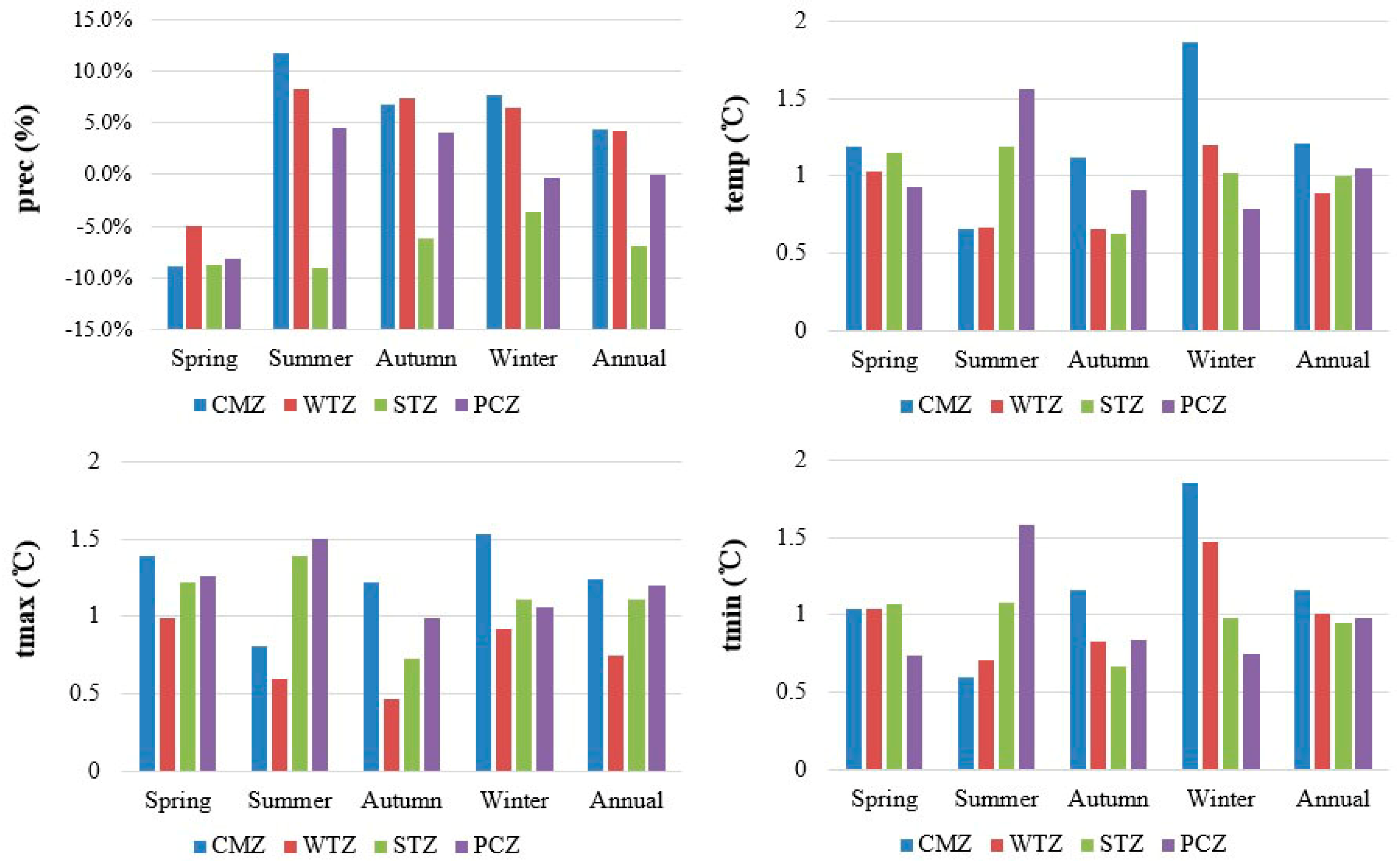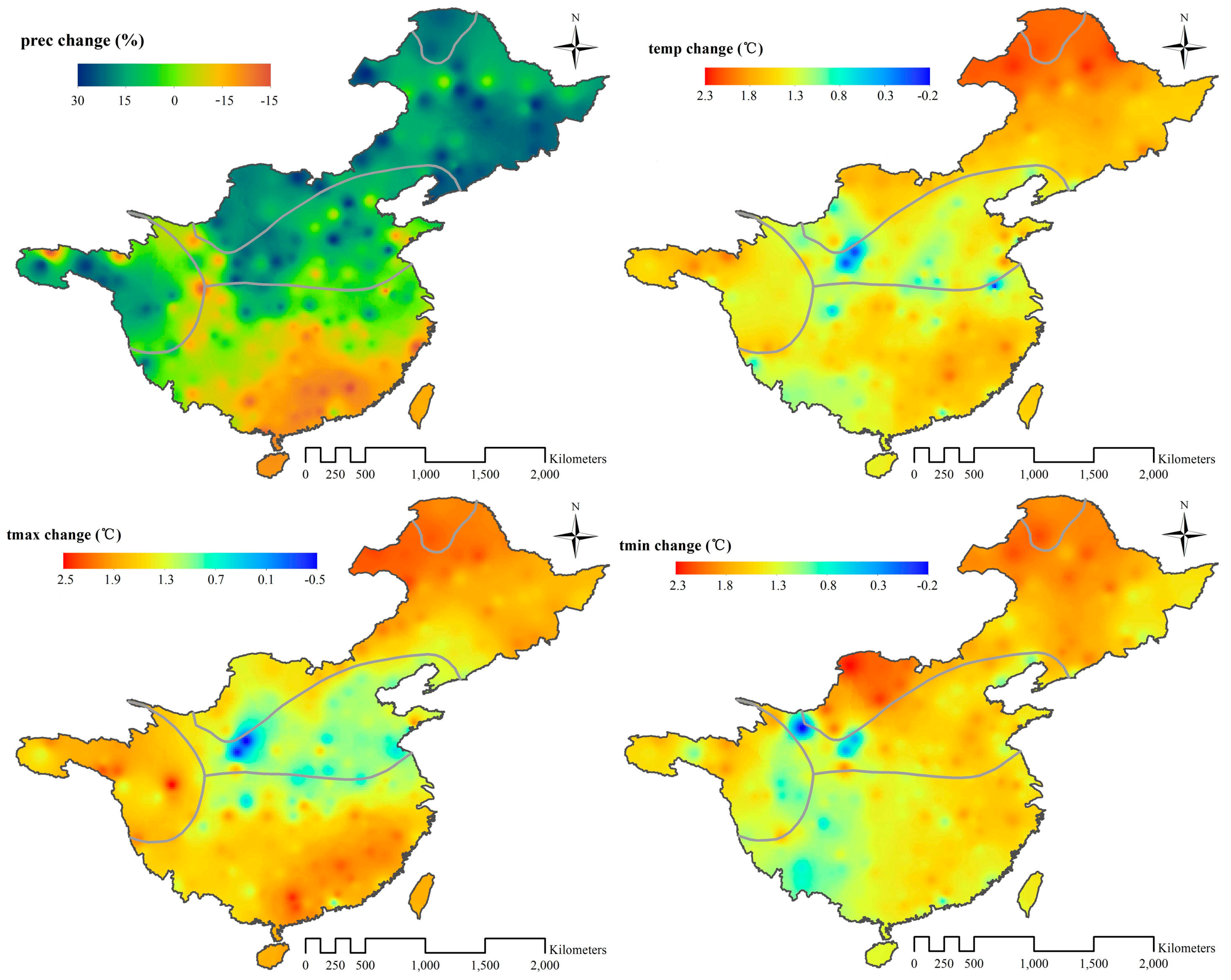Projection of Climate Change Scenarios in Different Temperature Zones in the Eastern Monsoon Region, China
Abstract
:1. Introduction
2. Study Area and Data Description
2.1. Study Area
2.2. Data Description
3. Methodology
3.1. Assessment on GCMs Performance
3.2. ASD (Automated Statistical Downscaling) Model
4. Results and Discussion
4.1. Assessment of GCMs Performance
4.2. Selection of Predictors
4.3. Calibration of ASD
4.4. Validation of ASD
4.5. Generation of Climate Change Scenarios
5. Methodological Limitations
6. Conclusions
Acknowledgments
Author Contributions
Conflicts of Interest
References
- Intergovernmental Panel on Climate Change (IPCC). Climate Change 2013: The Physical Science Basis; Contribution of Working Group I to the Fifth Assessment Report of the Intergovern-Mental Panel on Climate Change; Cambridge University Press: Cambridge, UK; New York, NY, USA, 2013. [Google Scholar]
- Gebremeskel, S.; Liu, Y.B.; de Smedt, F.; Hoffmann, L.; Pfister, L. Analysing the effect of climate changes on streamflow using statistically downscaled GCM scenarios. Int. J. River Basin Manag. 2005, 2, 271–280. [Google Scholar] [CrossRef]
- Ahmadalipour, A.; Rana, A.; Moradkhani, H.; Sharma, A. Multi-criteria evaluation of CMIP5 GCMS for climate change impact analysis. Theor. Appl. Climatol. 2015, 1–17. [Google Scholar] [CrossRef]
- Wilby, R.L.; Hay, L.E.; Gutowski, W.J.; Arritt, R.W.; Takle, E.S.; Pan, Z.; Leavesley, G.H.; Martyn, P.C. Hydrological responses to dynamically and statistically downscaled climate model output. Geophys. Res. Lett. 2000, 27, 1199–1202. [Google Scholar] [CrossRef]
- Gädeke, A.; Hölzel, H.; Koch, H.; Pohle, I.; Grünewald, U. Analysis of uncertainties in the hydrological response of a model-based climate change impact assessment in a subcatchment of the Spree River, Germany. Hydrol. Process. 2014, 28, 3978–3998. [Google Scholar] [CrossRef]
- Xu, C.Y. From GCMs to river flow: A review of downscaling methods and hydrologic modeling approaches. Prog. Phys. Geog. 1999, 23, 229–249. [Google Scholar] [CrossRef]
- Chu, J.; Xia, J.; Xu, C.Y.; Singh, V. Statistical downscaling of daily mean temperature, pan evaporation and precipitation for climate change scenarios in Haihe River, China. Theor. Appl. Climatol. 2010, 99, 149–161. [Google Scholar] [CrossRef]
- Khattak, M.S.; Babel, M.S.; Sharif, M. Hydro-meteorological trends in the Upper Indus River basin in Pakistan. Clim. Res. 2011, 46, 103–119. [Google Scholar] [CrossRef]
- Zhang, X.C.; Liu, W.Z.; Li, Z.; Chen, J. Trend and uncertainty analysis of simulated climate change impacts with multiple GCMS and emission scenarios. Agric. For. Meteorol. 2011, 151, 1297–1304. [Google Scholar] [CrossRef]
- Fowler, H.J.; Wilby, R.L. Beyond the downscaling comparison study. Int. J. Climatol. 2007, 27, 1543–1545. [Google Scholar] [CrossRef]
- Casanueva, A.; Herrera, S.; Fernández, J.; Gutiérrez, J.M. Towards a fair comparison of statistical and dynamical downscaling in the framework of the EURO-CORDEX initiative. Clim. Chang. 2016, 137, 411–426. [Google Scholar] [CrossRef]
- Boé, J.; Terray, L.; Habets, F.; Martin, E. Statistical and dynamical downscaling of the seine basin climate forhydro-meteorological studies. Int. J. Climatol. 2007, 27, 1643–1655. [Google Scholar] [CrossRef]
- Nover, D.M.; Witt, J.W.; Butcher, J.B.; Johnson, T.E.; Weaver, C.P. The effects of downscaling method on thevariability of simulated watershed response to climate change in five us basins. Earth Interact. 2016, 20, 1–27. [Google Scholar] [CrossRef]
- Wilby, R.L.; Wigley, T.M.L. Downscaling general circulation model output: A review of methods and limitations. Prog. Phys. Geogr. 1997, 21, 530–548. [Google Scholar] [CrossRef]
- Gutmann, E.D.; Rasmussen, R.M.; Liu, C.H. A comparison of statistical and dynamical downscaling of winter precipitation over complex terrain. J. Clim. 2012, 25, 262–281. [Google Scholar] [CrossRef]
- Kim, S.; Noh, H.; Jung, J. Assessment of the Impacts of Global Climate Change and Regional Water Projects on Streamflow Characteristics in the Geum River Basin in Korea. Water 2016, 8, 91. [Google Scholar] [CrossRef]
- Bergström, S.; Carlsson, B.; Gardelin, M. Climate change impacts on runoff in Sweden: Assessment by global climate models, dynamic downscaling and hydrological model. Clim. Res. 2001, 16, 101–112. [Google Scholar] [CrossRef]
- Xue, Y.; Vasic, R.; Janjic, Z. Assessment of Dynamic Downscaling of the Continental U.S. Regional Climate Using the Eta/SSiB Regional Climate Model. J. Clim. 2007, 20, 4172–4193. [Google Scholar] [CrossRef]
- Wilby, R.L.; Wigley, T.M.L.; Conway, D. Statistical downscaling of general circulation model output: A comparison of methods. Water Resour. Res. 1998, 34, 2995–3008. [Google Scholar] [CrossRef]
- Fan, L.J. Preliminary study of statistically downscaled temperature ensemble predictions in eastern China. Plateau Meteorol. 2010, 29, 392–402. [Google Scholar]
- Liu, J.; Yuan, D.; Zhang, L. Comparison of Three Statistical Downscaling Methods and Ensemble Downscaling Method Based on Bayesian Model Averaging in Upper Hanjiang River Basin, China. Adv. Meteorol. 2016, 2016, 1–12. [Google Scholar] [CrossRef]
- Zhang, X.; Yan, X. A new statistical precipitation downscaling method with Bayesian model averaging: A case study in China. Clim. Dynam. 2015, 45, 1–15. [Google Scholar] [CrossRef]
- Feddersen, H.; Andersen, U. A method for statistical downscaling of seasonal ensemble predictions. Tellus A 2005, 57, 398–408. [Google Scholar] [CrossRef]
- Zorita, E.; Storch, H.V. The Analog Method as a Simple Statistical Downscaling Technique: Comparison with More Complicated Methods. J. Clim. 1999, 12, 2474–2489. [Google Scholar] [CrossRef]
- Tatli, H.; Dalfes, H.N.; Menteş, Ş.S. A statistical downscaling method for monthly total precipitation over Turkey. Int. J. Climatol. 2004, 24, 161–180. [Google Scholar] [CrossRef]
- Chen, Y.D.; Chen, X.; Xu, C.Y.; Shao, Q. Downscaling of daily precipitation with a stochastic weather generator for the subtropical region in South China. Hydrol. Earth. Syst. Sci. Discuss. 2006, 3, 1145–1183. [Google Scholar] [CrossRef]
- Zhao, F.F.; Xu, Z.X. Comparative analysis on downscaled climate scenarios for headwater catchment of Yellow River using sds and delta methods. Acta Meteorol. Sin. 2007, 65, 653–662. [Google Scholar]
- Huang, J.X.; Xu, Z.X.; Liu, Z.F.; Zhao, F.F. Analysis of future climate change in the Taihu Basin using statistical downscaling. Resour. Sci. 2008, 30, 1811–1817. [Google Scholar]
- Liu, Z.F.; Xu, Z.X. Trends of daily extreme air temperature in the Wei River Basin in the future. Resour. Sci. 2009, 31, 1573–1580. [Google Scholar]
- Liu, P.; Xu, Z.X.; Li, X.P.; Wang, S.Z. Application of ASD Statistical Technique in Typical Basins of the Eastern monsoon region in China. J. Chin. Hydrol. 2013, 33, 1–9. [Google Scholar]
- Mcsweeney, C.F.; Jones, R.G.; Lee, R.W. Selecting CMIP5 GCMs for downscaling over multiple regions. Clim. Dynam. 2014, 44, 3237–3260. [Google Scholar] [CrossRef]
- Taylor, K.E. Summarizing multiple aspects of model performance in a single diagra. J. Geophys. Res. 2001, 106, 7183–7192. [Google Scholar] [CrossRef]
- Hessami, M.; Gachon, P.; Ouarda, T. Automated regression-based statistical downscaling tool. Environ. Model. Softw. 2008, 23, 813–834. [Google Scholar] [CrossRef]
- Mahmood, R.; Jia, S. Assessment of Impacts of Climate Change on the Water Resources of the Transboundary Jhelum River Basin of Pakistan and India. Water 2016, 8, 246. [Google Scholar] [CrossRef]
- Wilby, R.L.; Wigley, T.M. Precipitation predictor for downscaling: Observed and general circulation model relationships. Int. J. Climatol. 2000, 20, 641–661. [Google Scholar] [CrossRef]
- Wilby, R.L.; Tomlinson, O.J.; Dawson, C.W. Multi-site simulation of precipitation by conditional resampling. Clim. Res. 2003, 23, 183–194. [Google Scholar] [CrossRef]
- Wilby, R.L.; Dawson, C.W.; Barrow, E.M. SDSM-A decision support tool for the assessment of regional climate change impacts. Environ. Model. Softw. 2002, 17, 147–159. [Google Scholar] [CrossRef]
- Liu, L.L.; Liu, Z.F.; Xu, Z.X. Trends of climate change for the upper-middle reaches of the yellow river in the 21st century. Adv. Clim. Chg. Res. 2008, 4, 167–172. [Google Scholar]
- Chen, W.L. Projection and Evaluation of the Precipitation Extremes Indices over China. Master’s Thesis, Nanjing University of Information Science & Technology, Nanjing, China, 2008. [Google Scholar]
- Liu, L.; Xu, Z.X.; Huang, J.X. Comparative study on the application of two downscaling methods in the Taihu Basin. J. Meteorol. Sci. 2011, 31, 160–169. [Google Scholar]
- Huang, J.; Zhang, J.C.; Zhang, Z.X.; Xu, C.Y.; Wang, B.L.; Yao, J. Estimation of future precipitation change in the Yangtze River basin by using statistical downscaling method. Stoch. Env. Res. Risk Assess. 2011, 25, 781–792. [Google Scholar] [CrossRef]
- Hu, Y.J.; Zhu, Y.M.; Zhong, Z.; Zhang, H.J. Estimation of Precipitation in Two Climate Change Scenarios in China. Plateau Meteorol. 2013, 32, 778–786. [Google Scholar]
- Sun, J.L.; Lei, X.H.; Jiang, Y.Z.; Wang, H. Variation Trend Analysis of Meteorological Variables and Runoff in Upper Reaches of Yangtze River. Int. J. Hydroelectr. Energy 2012, 30, 1–4. [Google Scholar]








| No. | Model | Institution | Nation | Resolution |
|---|---|---|---|---|
| 1 | ACCESS1.3 | Commonwealth Scientific and Industrial Research Organization and Bureau of Meteorology | Australia | 145 × 192 |
| 2 | BCC-CSM1.1 | Beijing Climate Center, China Meteorological Administration | China | 64 × 128 |
| 3 | BNU-ESM | College of Global Change and Earth System Science, Beijing Normal University | China | 64 × 128 |
| 4 | CanESM2 | Canadian Centre for Climate Modelling and Analysis | Canada | 64 × 128 |
| 5 | CCSM4 | National Center for Atmospheric Research | America | 192 × 288 |
| 6 | CMCC-CESM | Centro Euro-Mediterraneo per I Cambiamenti Climatici | Europe | 48 × 96 |
| 7 | CNRM-CM5 | Centre National de Recherches Météorologiques/Centre Européen de Recherche et Formation Avancée en Calcul Scientifique | France | 128 × 256 |
| 8 | CSIRO-Mk3.6.0 | Commonwealth Scientific and Industrial Research Organization in collaboration with Queensland Climate Change Centre of Excellence | Australia | 96 × 192 |
| 9 | EC-EARTH | EC-EARTH consortium | Europe | 160 × 320 |
| 10 | FGOALS-g2 | LASG, Institute of Atmospheric Physics, Chinese Academy of Sciences and CESS,Tsinghua University | China | 60 × 128 |
| 11 | GFDL-CM3 | NOAA Geophysical Fluid Dynamics Laboratory | America | 90 × 144 |
| 12 | GISS-E2-R | NASA Goddard Institute for Space Studies | America | 90 × 144 |
| 13 | HadGEM2-AO | National Institute of Meteorological Research/Korea Meteorological Administration | Korea | 145 × 192 |
| 14 | HadGEM2-CC | Met Office Hadley Centre | England | 145 × 192 |
| 15 | INMCM4 | Institute for Numerical Mathematics | Russia | 120 × 180 |
| 16 | IPSL-CM5A-LR | Institut Pierre-Simon Laplace | France | 96 × 96 |
| 17 | MIROC-ESM | Japan Agency for Marine-Earth Science and Technology, Atmosphere and Ocean Research Institute (The University of Tokyo), and National Institute for Environmental Studies | Japan | 64 × 128 |
| 18 | MPI-ESM-LR | Max Planck Institute for Meteorology | Germany | 96 × 192 |
| 19 | NorESM1-M | Norwegian Climate Centre | Norway | 96 × 144 |
| Scholar | Research Area | Percentage of Explained Variance (%) | |||
|---|---|---|---|---|---|
| Precipitation | Mean Air Temperature | Maximum Air Temperature | Minimum Air Temperature | ||
| Zhao and Xu [27] | Source of Yellow River Basin | 7.00–25.3 | 49.5–55.4 | 23.8–27.51 | |
| Liu et al. [38] | Upper-middle reaches of Yellow River | 8.0–20.0 | 63.0–69.0 | >64.0 | |
| Chu et al. [7] | Hai River Basin | 99.36–99.64 | |||
| Chen [39] | Yangtze-Huaihe River Basin | 8.8–20.6 | |||
| Liu and Xu [29] | Wei River Basin | 70.8–89.1 | 63.8–8601 | ||
| Liu et al. [40] | Taihu Basin | 20.8–33.0 | 70.1–80.1 | 75.4–84.5 | |
| This research | Eastern monsoon region, China | 13.0–27.9 | 84.5–97.0 | 77.1–96.1 | 82.2–96.1 |
| Zones | Precipitation | Mean Air Temperature | Maximum Air Temperature | Minimum Air Temperature | ||||
|---|---|---|---|---|---|---|---|---|
| R | NRMSE | R | NRMSE | R | NRMSE | R | NRMSE | |
| CMZ | 0.47 * | 1.30 | 0.90 *** | 0.46 | 0.87 *** | 0.55 | 0.89 *** | 0.48 |
| WTZ | 0.39 | 1.40 | 0.89 *** | 0.50 | 0.80 *** | 0.66 | 0.88 *** | 0.51 |
| STZ | 0.24 | 1.47 | 0.80 *** | 0.62 | 0.70 *** | 0.79 | 0.83 *** | 0.59 |
| PCZ | 0.33 | 1.35 | 0.84 *** | 0.57 | 0.70 *** | 0.80 | 0.83 *** | 0.58 |
| Zones | Probability of Wet Days | Mean Rainfall of Wet Days | ||
|---|---|---|---|---|
| Er (%) | R2 | Er (mm/Day) | R2 | |
| CMZ | −1.25 | 0.906 | −0.38 | 0.923 |
| WTZ | 1.45 | 0.897 | 0.62 | 0.910 |
| STZ | 0.71 | 0.872 | 1.05 | 0.874 |
| PCZ | 1.72 | 0.839 | −0.17 | 0.861 |
© 2017 by the authors. Licensee MDPI, Basel, Switzerland. This article is an open access article distributed under the terms and conditions of the Creative Commons Attribution (CC BY) license (http://creativecommons.org/licenses/by/4.0/).
Share and Cite
Liu, P.; Xu, Z.; Li, X. Projection of Climate Change Scenarios in Different Temperature Zones in the Eastern Monsoon Region, China. Water 2017, 9, 305. https://doi.org/10.3390/w9050305
Liu P, Xu Z, Li X. Projection of Climate Change Scenarios in Different Temperature Zones in the Eastern Monsoon Region, China. Water. 2017; 9(5):305. https://doi.org/10.3390/w9050305
Chicago/Turabian StyleLiu, Pin, Zongxue Xu, and Xiuping Li. 2017. "Projection of Climate Change Scenarios in Different Temperature Zones in the Eastern Monsoon Region, China" Water 9, no. 5: 305. https://doi.org/10.3390/w9050305






